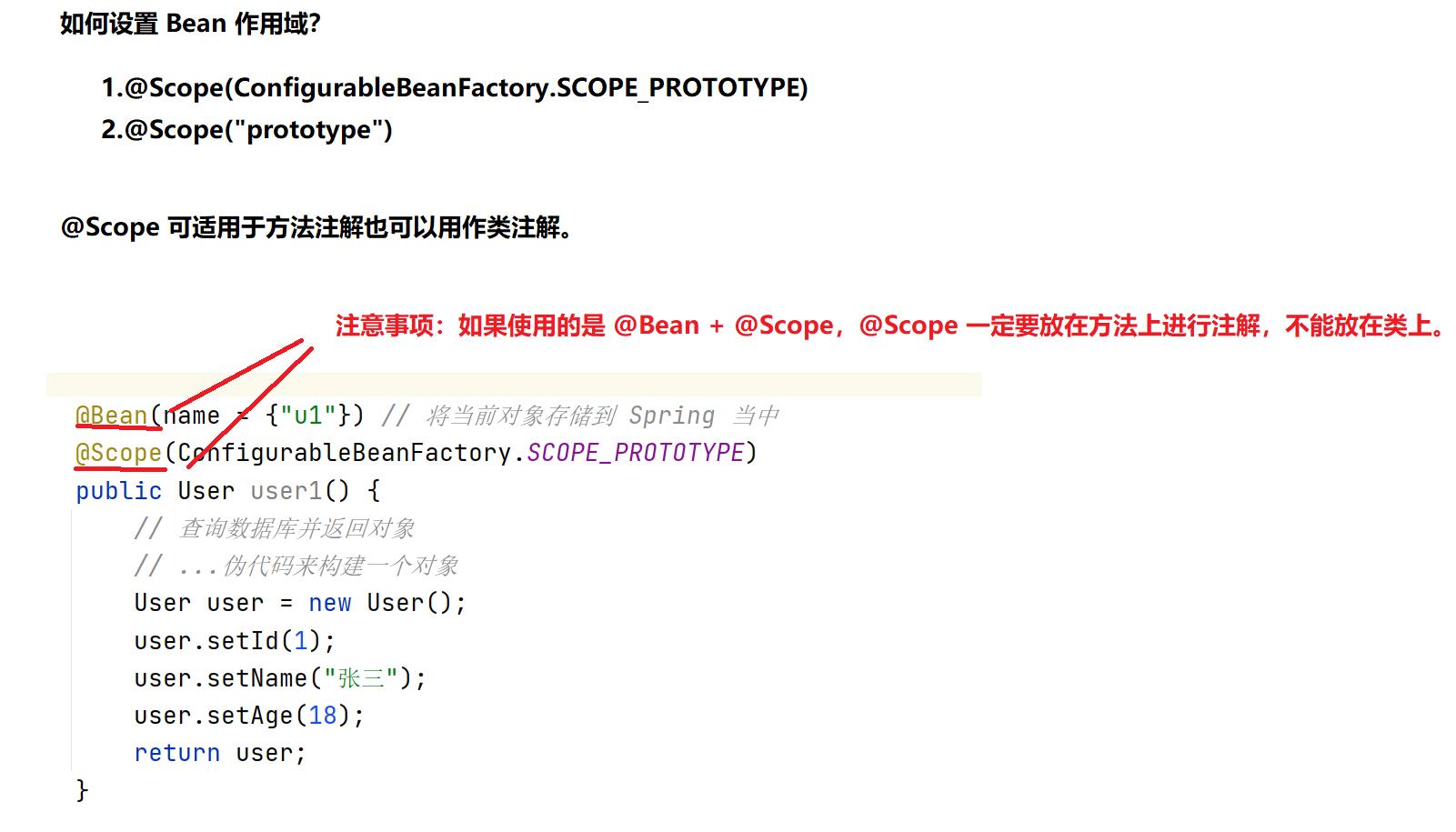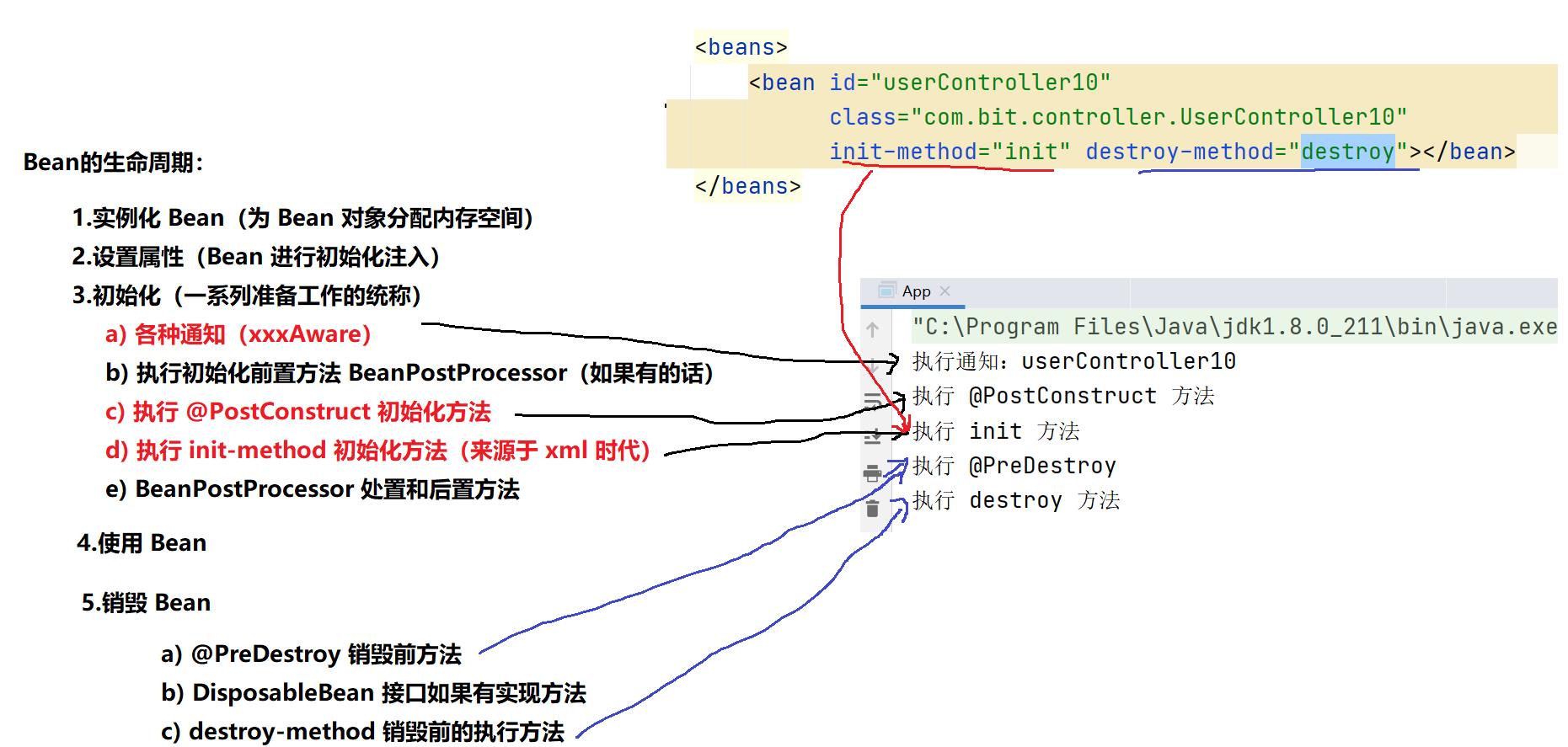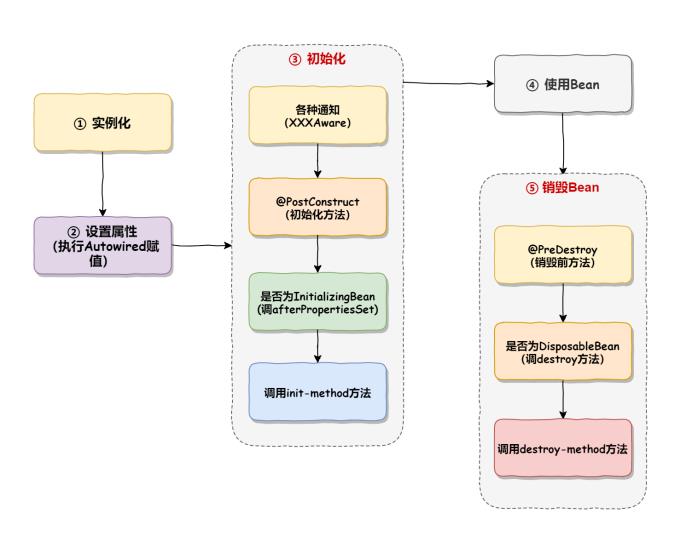Spring详解Bean的六种作用域执行流程生命周期
Posted Perceus
tags:
篇首语:本文由小常识网(cha138.com)小编为大家整理,主要介绍了Spring详解Bean的六种作用域执行流程生命周期相关的知识,希望对你有一定的参考价值。
@TOC
Bean 作⽤域和⽣命周期
从前⾯的博客我们可以看出 Spring 是⽤来读取和存储 Bean,因此在 Spring 中 Bean 是最核⼼的操作资源,所以接下来我们深⼊学习⼀下 Bean 对象
通过⼀个案例来看 Bean 作⽤域的问题
假设现在有⼀个公共的 Bean,提供给 A ⽤户和 B ⽤户使⽤,然⽽在使⽤的途中 A ⽤户却 悄悄 地修改了公共 Bean 的数据,导致 B ⽤户在使⽤时发⽣了预期之外的逻辑错误。
被修改的 Bean 案例
公共 Bean:
@Component
public class Users
@Bean
public User user1()
User user = new User();
user.setId(1);
user.setName("Java"); // 【重点:名称是 Java】
return user;
A ⽤户使⽤时,进⾏了修改操作:
@Controller
public class BeanScopesController
@Autowired
private User user1;
public User getUser1()
User user = user1;
System.out.println("Bean 原 Name:" + user.getName());
user.setName("悟空"); // 【重点:进⾏了修改操作】
return user;
B ⽤户再去使⽤公共 Bean 的时候:
@Controller
public class BeanScopesController2
@Autowired
private user1;
public User getUser1()
User user = user1;
return user;
打印 A ⽤户和 B ⽤户公共 Bean 的值:
public class BeanScopesTest
public static void main(String[] args)
ApplicationContext context = new
ClassPathXmlApplicationContext("spring-config.xml");
BeanScopesController beanScopesController =
context.getBean(BeanScopesController.class);
System.out.println("A 对象修改之后 Name:" +
beanScopesController.getUser1().toString());
BeanScopesController2 beanScopesController2 =
context.getBean(BeanScopesController2.class);
System.out.println("B 对象读取到的 Name:" +
beanScopesController2.getUser1().toString());
执⾏结果如下:

原因分析
作用域定义
限定程序中变量的可⽤范围叫做作⽤域,或者说在源代码中定义变量的某个区域就叫做作⽤域。
Bean 的 6 种作用域
Spring 容器在初始化⼀个 Bean 的实例时,同时会指定该实例的作⽤域。
Spring有 6 种作⽤域, 最后四种是基于 Spring MVC ⽣效的:

| 作用域 | 描述 |
|---|---|
| singleton | 单例作用域,在整个Spring IoC容器仅存在一个Bean实例,Bean以单例方式存在 |
| prototype | 原型作用域,每次从容器中调用Bean时,都返回一个新的实例。即每次调用getBean时,相当于执行newXxxBean方法 |
| request | 请求作用域,每次Http请求都会创建一个新的Bean |
| session | 会话作用域,同一个Http Session共享一个Bean,不同Session使用不同的Bean |
| application | 全局作用域,在一个Http Servlet Context中,定义一个Bean. |
| websocket | 在一个WebSocket的生命周期中,定义一个Bean实例 |
1. 普通 Spring 环境:
① singleton
代码举例:
创建TestSingleton类作为bean:
package com;
import org.springframework.stereotype.Component;
@Component
public class TestSingleton
private String message;
public void setMessage(String message)
this.message = message;
public void getMessage()
System.out.println("Your Message : " + message);
在测试类中同时尝试获取两个bean,看输出信息是否相同,相同即同一个实例:
import com.Controller.UserController;
import com.TestSingleton;
import com.User.User;
import org.springframework.context.ApplicationContext;
import org.springframework.context.support.ClassPathXmlApplicationContext;
public class App
public static void main(String[] args)
ApplicationContext context=new ClassPathXmlApplicationContext("a.xml");
TestSingleton testSingleton_A=(TestSingleton)context.getBean("testSingleton");
System.out.println("下面是第一个bean的信息:");
testSingleton_A.setMessage("This is A!");
testSingleton_A.getMessage();
TestSingleton testSingleton_B=(TestSingleton)context.getBean("testSingleton");
System.out.println("下面是第二个bean的信息:");
testSingleton_B.getMessage();
输出:
下面是第一个bean的信息:
Your Message : This is A!
下面是第二个bean的信息:
Your Message : This is A!② prototype
代码举例:
创建TestPrototype类作为bean,通过注解Scope将作用域类型设置为prototype:
package com;
import org.springframework.context.annotation.Scope;
import org.springframework.stereotype.Component;
@Component
@Scope("prototype") // 注解生效
public class TestPrototype
private String message;
public void setMessage(String message)
this.message = message;
public void getMessage()
System.out.println("Your Message : " + message);
在测试类中获取两个bean,看输出信息是否相同,相同即是同一个实例,不同则是不同的实例:
import com.TestPrototype;
import org.springframework.context.ApplicationContext;
import org.springframework.context.support.ClassPathXmlApplicationContext;
public class App
public static void main(String[] args)
ApplicationContext context=new ClassPathXmlApplicationContext("a.xml");
TestPrototype testSingleton_A=(TestPrototype)context.getBean("testPrototype");
System.out.println("下面是第一个bean的信息:");
testSingleton_A.setMessage("This is A!");
testSingleton_A.getMessage();
TestPrototype testSingleton_B=(TestPrototype)context.getBean("testPrototype");
System.out.println("下面是第二个bean的信息:");
testSingleton_B.getMessage();
输出:
下面是第一个bean的信息:
Your Message : This is A!
下面是第二个bean的信息:
Your Message : null2. Spring Web 环境:
在使用Web环境相关的作用域时,必须在Web容器中进行一些额外的配置:
- 如果使用的是Spring MVC框架,就不需这些配置,因为每一次http请求都会通过
DispatcherServlet来处理,而DispatcherServlet中已经配置好了相关状态。 - 如果是低版本的web容器,需要在配置的XML文件中添加如下声明即可:
<web-app>
...
<listener>
<listener-class>
org.springframework.web.context.request.RequestContextListener
</listener-class>
</listener>
...
</web-app>还可以使用Spring中的RequestContextFilter或者ServletRequestListener和其他方式,这里不再详细介绍。
③ request
request是请求作用域
在进行使用时,也是在scope属性中声明:
<bean id="" class="" scope="request"/>④ session
session是会话作用域
同一个Http Session(会话)之间共享一个bean,而不同的会话使用不同的bean.
在使用时,可以在scope属性中声明:
<bean id="user" class="" scope="session"/>⑤ application
application是全局作用域。
使用方式:
<bean id="app" class="" scope="application"/>假设bean的id为app,Spring容器会在整个web应用范围使用到app的时候创建一个新的实例。也就是说,appBean是在ServletContext级别的.。
单例作⽤域(singleton)和全局作⽤域(application)区别
如何设置 Bean 作用域
1. 通过xml配置文件
<?xml version="1.0" encoding="UTF-8"?>
<beans xmlns="http://www.springframework.org/schema/beans"
xmlns:xsi="http://www.w3.org/2001/XMLSchema-instance"
xsi:schemaLocation="
http://www.springframework.org/schema/beans http://www.springframework.org/schema/beans/spring-beans.xsd">
//scope属性
<bean id="SingletonBean" class="com.spring.demo.SingletonBean" scope="prototype"> </bean>
</beans>2. 通过注解
在bean上添加注解:

package com.spring.demo;
import org.springframework.context.annotation.Scope;;
import org.springframework.stereotype.Component;
@Component("SingletonBean")
@Scope("prototype")
//@Scope("ConfigurableBeanFactory.SCOPE_PROTOTYPE")
public class SingletonBean
private String message;
public void setMessage(String message)
this.message = message;
public void getMessage()
System.out.println("Your Message : " + message);
Bean 执行流程


Bean ⽣命周期
Bean的生命周期指一个Bean对象从“出生”到“销毁”的过程,可以表达为:
具体过程如下:
销毁容器的各种⽅法,如 @PreDestroy、DisposableBean 接⼝⽅法、destroy-method。

执⾏流程如下图所示:

1. 实例化和初始化的区别
2. ⽣命流程的“故事”
Bean 的⽣命流程看似繁琐,但咱们可以以⽣活中的场景来理解它。
⽐如我们现在需要买⼀栋房⼦,那 么我们的流程是这样的:
⽣命周期演示
import com.bit.service.UserService;
import org.springframework.beans.factory.BeanNameAware;
import org.springframework.beans.factory.annotation.Autowired;
import javax.annotation.PostConstruct;
import javax.annotation.PreDestroy;
public class UserController10 implements BeanNameAware
@Autowired
private UserService userService;
@Override
public void setBeanName(String s)
System.out.println("执行通知:" + s);
// 初始化方法
@PostConstruct
public void postConstruct()
System.out.println("执行 @PostConstruct 方法");
public void init() // init() 方法名字可以随便起,只需要和 xml 中的名称保持一致即可
System.out.println("执行 init 方法");
@PreDestroy
public void preDestroy()
System.out.println("执行 @PreDestroy");
public void destroy()
System.out.println("执行 destroy 方法");
xml 配置如下:
<?xml version="1.0" encoding="UTF-8"?>
<beans xmlns="http://www.springframework.org/schema/beans"
xmlns:xsi="http://www.w3.org/2001/XMLSchema-instance"
xmlns:content="http://www.springframework.org/schema/context"
xsi:schemaLocation="http://www.springframework.org/schema/beans http://www.springframework.org/schema/beans/spring-beans.xsd http://www.springframework.org/schema/context https://www.springframework.org/schema/context/spring-context.xsd">
<!-- 配置 Spring 扫描的根路径(此根路径下的所有 Spring 存对象的注解才能生效) -->
<content:component-scan base-package="com.bit"></content:component-scan>
<beans>
<bean id="userController10"
class="com.bit.controller.UserController10"
init-method="init" destroy-method="destroy"></bean>
</beans>
</beans>启动类:
/**
* Spring 启动类(非必须,为了方便演示 Spring 的功能而创建)
*/
public class App
public static void main(String[] args)
// 1.先获取对象的
ClassPathXmlApplicationContext context = new ClassPathXmlApplicationContext("spring.xml");
UserController10 userController10 = context.getBean("userController10", UserController10.class);
context.destroy(); // 销毁方法
效果如下:

以上是关于Spring详解Bean的六种作用域执行流程生命周期的主要内容,如果未能解决你的问题,请参考以下文章